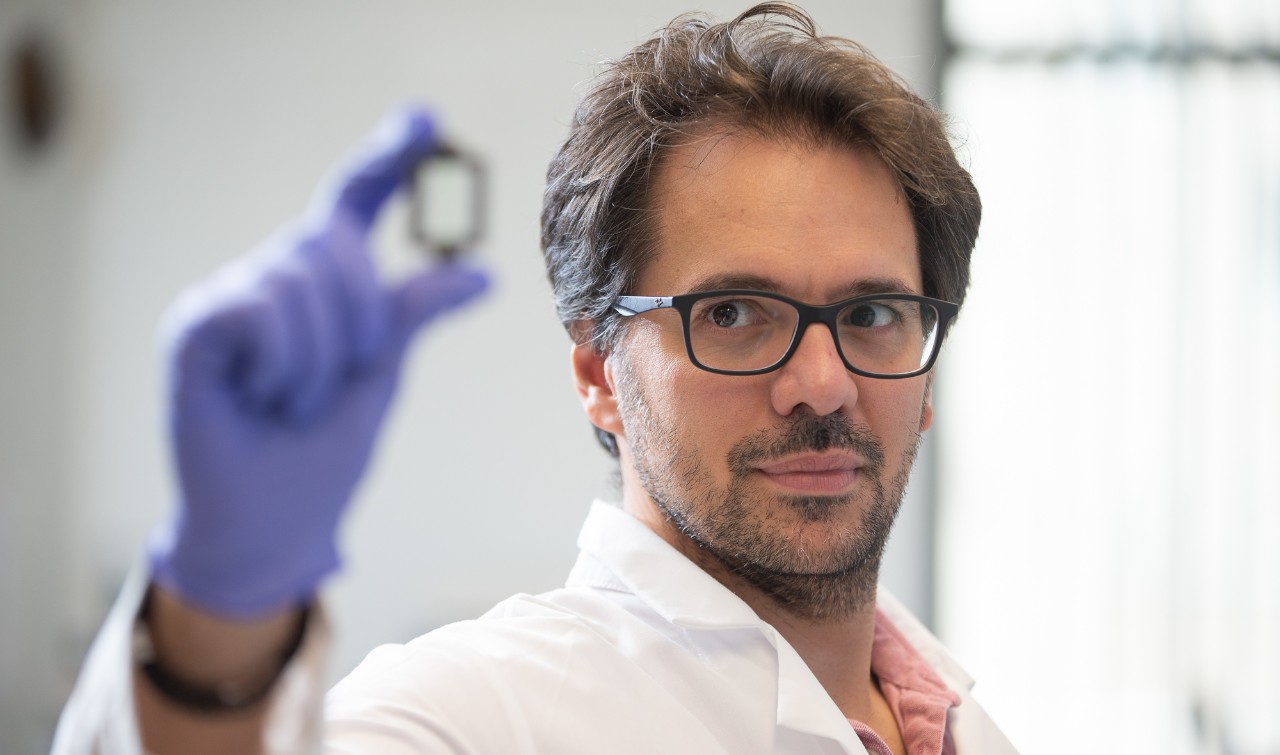
Engineers apply new tech to model deadly brain tumors
Bioprinted blood vessels could speed testing of treatments for cancer
Glioblastoma is a brain cancer with very poor survival outcomes.
Most drugs can’t cross the blood-brain barrier, which means that unlike other cancers, there just aren’t that many therapies available for brain tumors.
But a cutting-edge technology developed at the University of Cincinnati aims to change that. Researchers are using 3D bioprinting to create artificial blood vessels that can be used to test new custom-tailored drugs and study why glioblastoma is so resilient.
“Our goal is to develop models that can be used to get new insights into the mechanism that promotes tumor regeneration and drug resistance enabling testing of new therapeutics,” said Riccardo Barrile, an assistant professor of biomedical engineering in UC’s College of Engineering and Applied Science.
The study was published in the journal Advanced Healthcare Materials.

UC doctoral student Sirjana Pun uses a 3D printer to create bioprinted devices that mimic blood vessels in Riccardo Barrile's biomedical engineering lab. Photo/Andrew Higley/UC Marketing + Brand
Organs-on-a-chip
“Glioblastoma is the most aggressive form of primary brain tumor. It’s typically lethal,” Barrile said. “It’s a terrible disease.”
Doctors typically prescribe chemotherapy in combination with surgical removal of the tumors and radiation therapy. But glioblastoma is resilient and typically becomes drug resistant over time, he said.
“It’s difficult to target these tumors,” he said. “They are strategically infiltrated in healthy parts of brain tissue.”
The first “organs-on-a-chip” were made less than 20 years ago. It’s a field that holds a lot of promise in the field of drug development, but is in its infancy, Barrile said.
Using standard technology, organs on a chip can take months to make. But Barrile and his students can use 3D bioprinting to create custom synthetic blood vessels far more quickly for each patient.
“Molds are generated using classic manufacturing techniques. It can take weeks to months to generate a prototype. Our 3D printing approach takes just a few hours,” he said.
And that opens a world of research and treatment possibilities, he said.

Bioprinting is a new frontier of research and medicine that one day could replace the need for animals in medical testing. Photo/Andrew Higley/UC Marketing + Brand
Likewise, Barrile said traditional organs-on-a-chip use silicon materials. But the drugs needed to treat glioblastoma are small-molecule drugs — so small that they easily can get absorbed into the silicon form instead of the tissue where it is needed.
“We’re not using silicon materials but microfluidic hydrogels. That’s an advantage because silicon devices deplete the drug’s efficacy. The molecules just disappear into the framework,” he said.
Organs-on-a-chip could one day eliminate the need for medical testing on animals, Barrile said.

UC doctoral student Sirjana Pun says bioprinted devices hold a lot of promise in developing custom treatments for patients. Photo/Andrew Higley/UC Marketing + Brand
Creating custom therapies
Lead author Sirjana Pun, a doctoral student in biomedical engineering at UC, said organs-on-a-chip devices hold great potential for advancing the development of new therapies.
"Existing glioblastoma treatments follow a one-size-fits-all approach, which has proven ineffective in significantly improving patient survival. Our system can be utilized to create personalized disease models, enabling the testing of novel therapies tailored to each patient's unique needs,” she said.
“I’m grateful for the research opportunity at UC to work in a field I’m deeply passionate about,” Pun said.
They collaborated with Soma Sengupta from the University of North Carolina, Daniel Pomeranz Krummel at the University of North Carolina and Giuseppe Sciumé from the University of Bordeaux in France. UC biomedical engineering students Dalee Demaree and Anusha Prakash also contributed. The study was supported by the UC Office of Research and UC’s Gardner Neuroscience Institute.
“I’m glad to be part of this society as we work together with other scientists in academia, industry and regulatory agencies to drive adoption of this technology with the long-term idea of replacing animal models and providing alternative methods for drug testing,” Barrile said.
Featured image at top: UC Assistant Professor Riccardo Barrile is studying bioprinting technology to help cancer patients in his biomedical engineering lab. Photo/Andrew Higley/UC Marketing + Brand

UC Assistant Professor Riccardo Barrile is studying ways to use bioprinted devices to speed up medical tests to treat conditions such as glioblastoma. Photo/Andrew Higley/UC Marketing + Brand
Next Lives Here
The University of Cincinnati is leading public urban universities into a new era of innovation and impact. Our faculty, staff and students are saving lives, changing outcomes and bending the future in our city's direction. Next Lives Here.
Related Stories
How to prevent concussions in football? Better helmets
March 6, 2023
Football helmets made by four leading manufacturers showed vulnerabilities in tests designed to better understand player concussions, according to a study by the University of CIncinnati.
Engineers apply new tech to model deadly brain tumors
September 25, 2024
Researchers are using 3D bioprinting to create artificial blood vessels that can be used to test new custom-tailored drugs and study why brain tumors are so resilient.
Getting under your skin for better health
January 20, 2023
Biomedical engineers at the University of Cincinnati say interstitial fluid, the watery fluid found between and around cells, tissues or organs in the body, could provide an excellent medium for early disease diagnosis or long-term health monitoring.
